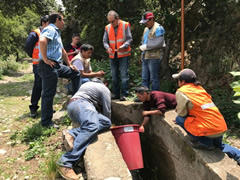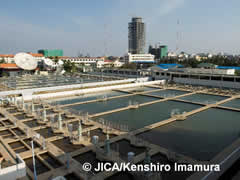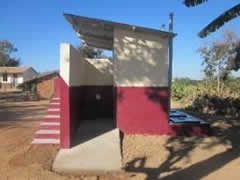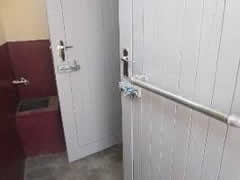Case Study 1
Support to the Solution of Various Water Issues through Integrated Water Resources Management in Cooperation with Stakeholders
Bolivia: "Project for Capacity Development on Integrated Water Management in Cochabamba" (2016-2021)
Rocha River Basin, which includes the metropolitan area of Cochabamba having the third largest population in Bolivia, is an important basin. Water shortages in this area is becoming common, and there is competition as well as conflict between domestic and irrigation water use, arising from water use between upstream and downstream users. There is also a serious deterioration of water quality, and pressure to respond to flood risks. In response to these issues, administrative agencies, centered in the Cochabamba Department Office, need to manage water resources while coordinating various issues and interests with residents and other stakeholders.

Project members conducting a water quality survey
The project aims to strengthen the capacity of the Cochabamba Department Office to promote IWRM, and plan and coordinate related projects. To accomplish this project purpose, JICA implements activities such as, reviewing local legal systems, improvement of monitoring system, strengthening the capacity for water resources assessments, extracting lessons from a pilot project for the implementation process of IWRM, and strengthening the cooperation mechanisms among the stakeholders.
Case Study 2
Cambodia: Formulation of the Master Plan, which brought about the "Miracle of Phnom Penh", and the Support for Comprehensive Capacity Development in the Cambodian Water Supply Sector (1993-)
In 1993 JICA formulated the Master Plan for the restoration of water supply service in the Cambodian capital of Phnom Penh which had been devastated by civil war. This plan provided the blueprint to call for funding from other development partners for the reconstruction and expansion of facilities, and JICA itself provided broad support in the form of financial and technical cooperation for the implementation of many projects in line with the Master Plan. At the same time, the Director General of the Phnom Penh Water Supply Authority (PPWSA), H.E. Ek Sonn Chan took the opportunity to promote this Master Plan with various reforms such as improvement of water tariff collection, leakage reduction and the installation of water meters etc. This led to incredible improvements in water services, which became known as the "Miracle of Phnom Penh", where the PPWSA achieved a 24-hour continuous water supply, safe water quality which met WHO guidelines, and appropriate water pressure etc. in less than 10 years.

Phum Prek Water Treatment Plant developed with the support of Japan
To expand the good practice of the PPWSA to other major cities nationwide, JICA is expanding technical cooperation targeting the provincial waterworks in other regions utilizing staff of PPWSA as lecturers.
This was also accompanied by financial cooperation for the development of facilities, increasing the service population, and associated improvements in financial conditions. The scope of technical cooperation began with the improvement of service levels through enhanced operation and maintenance capacity, and developed progressively to strengthen management capacity and human resources development, as the capacity of the waterworks improved.
A government agency responsible for water supply was also included as the target for technical cooperation, with support for the formulation of the water supply law, and the enhancement of monitoring capabilities of provincial waterworks.
Case Study 3
Toilet and Handwashing Facilities which are Easy to Use by Anyone
Mozambique: "The Project on Promoting Sustainability in Rural Water Supply, Hygiene and Sanitation in Niassa Province" (2013-2017)
This project targeted four districts in Niassa Province located in Northern Mozambique, and included activities such as building and repairing water supply facilities with deep wells and hand pumps, strengthening the maintenance system of those facilities, constructing and providing guidance on the maintenance of elementary school toilets with handwashing facilities, and raising awareness on sanitation and hygiene using the Community-Led Total Sanitation (CLTS) method aimed at eliminating open defecation.
The construction of elementary school toilets involves not only the ease of maintenance, sustainability and cost reduction, but also toilet design which considered the perspective of users. More specifically, to make toilets easier to use for girls that are shy about being seen by others and for Muslim religious considerations, all individual toilets had doors attached, and a long blind-wall was constructed in front of the toilets, with handwashing taps on the other side. Also, wide doors, slopes, handrails and stools were placed for the use of people with disabilities who use wheelchairs or canes.
The manual for awareness-raising activities of Water and Sanitation Committees which manage facilities includes a statement on gender consideration, and the membership of the committee was adjusted to 1:1 of male and female ratio to make it possible for women to participate in decision-making.

Slope installed for wheelchair and walking stick users

Doors installed in private girl's toilets
For more case studies
Articles
- Sustainable management of small-town water supply in Nepal: improvement through the multi-stage training mechanism (2024)
- JICA Authored Articles “Prepaid water meters and water distribution system improvement: A case study of Jenin city, Palestine” (December 2023)
- JICA Authored Articles “Improvement of water utility management in Tajikistan: reduction in water wastage using a metered tariff system” (2023)
- JICA Authored Articles “Sustainable management of water utility in Samoa through services improvement with Okinawa Water Bureaus” (2022)
- JICA Authored Articles “Practicality of integrated water resources management (IWRM) in different contexts” (2021)
- JICA Authored Articles “Revenue augmentation through improved water supply services: A case study of the smart-wasa team of Faisalabad, Pakistan” (2021)
Project Brief Note
- JICA Project Brief Note "Project for Promoting Countermeasures against Land Subsidence in Jakarta" (November 2022) (PDF/3.58MB)
- JICA Project Brief Note "Project for Strengthening the Capacity of Water Service Management in Jenin Municipality in Palestine" (October 2022) (PDF/2.54MB)
- JICA Project Brief Note "The Project for Operation & Maintenance for Rural Water Supply and Improved Hygiene and Sanitation in the Republic of Uganda" (August 2022) (PDF/1.55MB)
- JICA Project Brief Note "The Project for Strengthening the Water Service Management of Pyanj and Khamadoni Vodokanals in the Republic of Tajikistan" (July 2021) (PDF/1.08MB)
- JICA Project Brief Note "Project for Water Supply, Sewerage and Drainage Master Plan of Faisalabad in Pakistan" (May 2019) (PDF/2.06MB)
- JICA Project Brief Note "Project for Strengthening Operation and Maintenance of Rural Water Supply Systems in Rwanda" (June 2018) (PDF/933KB)
- JICA Project Brief Note "The Project for Sustainable Rural Water Supply, Sanitation and Hygiene Promotion in Niassa Province, Republic of Mozambique" (February 2017) (PDF/780KB)
- JICA Project Brief Note "The Project for Improvement of Non-Revenue Water Reduction Capacity for SIWA in Solomon Islands" (August 2016) (PDF/1.11MB)
- JICA Project Brief Note "Improvement of Management Capacity of Operation and Maintenance for Water Supply Facilities in Nile Delta Area, the Arab Republic of Egypt" (April 2015) (PDF/668KB)




scroll